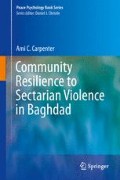Abstract
Nation and state building in Iraq remains a fragile and fraught enterprise, but mechanisms for strengthening community resilience and conflict prevention exist. This chapter argues for a “middle-ground” approach to peacebuilding that integrates structural with relational approaches, in order to address social reconciliation through institutional restructuring. Ultimately, enhancing resilience means looking for sources of adaptive capacity and finding ways to support locally driven initiatives whose outcomes support strengthening of the institutional context giving rise to them.
If you look beyond the short term violence and instability, you do see significant activities on the part of the Iraqi people that indicate they understand the commitment necessary to govern themselves. It’s not clear how they will do it, but it never is.
Bob Kerrey
Access this chapter
Tax calculation will be finalised at checkout
Purchases are for personal use only
Notes
- 1.
This is my personal opinion, however the ‘depth of trauma’ can be assessed by looking at various indicators: to name only a few, the duration of traumatic incidents (bombings, assassinations, military incursions); the number of people killed and injured; effects on families of the killed and injured; and the effects of violence on overall economic and human development.
- 2.
Ibid.
- 3.
- 4.
Carver [13]: 256.
- 5.
Experts at a 2011 conference on conflict prevention reached this conclusion, among othersc. Ganson and Wennman.
- 6.
- 7.
Miller and Rasco [18]: 43.
- 8.
Ryan, J. 2012. Infrastructures for peace as a path to resilience societies: a institutional perspective. Journal of Peacebuilding and Development 7(2):23.
- 9.
Calhoun and Tedeschi [22], Saakvitne et al. (1998);
- 10.
Saakvitne et al. 282.
- 11.
Bloom, Sandra [23]: 208.
- 12.
ibid.
- 13.
Ganson and Wennman.
- 14.
Carpenter [27].
- 15.
Ganson and Wennman.
- 16.
Ibid.
- 17.
Ganson and Wennmann p. 4.
References
Mahdi, Abdul Adel. 2013. Government is a failure and Iraqis are hostages. Al Adala Newspaper, 26 April 2013.
Lemay-Hébert, Nicolas. 2009. Statebuilding without nation-building? Legitimacy, state failure and the limits of the institutionalist approach. Journal of Intervention and Statebuilding 3(1): 21–45.
Azeez, Hawzhin. 2010. Reconstructing Iraq: Iraq state-building nation-building and violence. Nebula 7(4): 78.
Clark, Helen. 2012. Putting resilience at the heart of the development agenda. Speech given at Cambridge University, 16 April.
Lederach, John P. 1997. Building peace: Sustainable reconciliation in divided societies. Washingon D.C.: United States Institute of Peace, p. 29.
Culbertson, R. and Pouligny, B. 2007. Re-imagining peace after violent crime. In after mass crime: Rebuilding states and communities.
Jean Mendieta Jiménez and Enrique Pasta Muñuzuri. 2013. Diplomado en Ciudadanía para la Paz y Resolución de Conflictos. Acapulco: Universidad Loyola.
Cobb, Sara. 1994. A narrative perspective on mediation: Toward the materialization of the storytelling metaphor. In New directions in mediation: Communication research and perspectives, eds. J.P. Folger and T.S. Jones, Thousand Oaks, CA: Sage.
Cobb, Sara. 2004. Fostering coexistence in identity-based conflicts: Towards a narrative approach. In Imagine coexistence, eds. A. Chayes and M. Minow, Joseey Bass: San Francisco.
Ross, M. H. 2013. The politics of memory and peacebuilding. In Handbook of Peacebuilding. New York: Routledge, 91–102.
Buchanan, G. M., and Seligman, M. E. P. eds. 1995. Explanatory style. Hillsdale, NJ: Erlbaum.
Seligman, M.E.P. (1991). Helplessness: On Depression, Development and Death. Second edition. New York: W.H. Freeman.
Carver, C.S. 1998. Resilience and Thriving: Issues, Models and Linkages. Journal of Social Issues 54(2): 245–266.
Kumar, K. 1999. Promoting Social Reconciliation in Postconflict Societies: Selected Lessons from USAID's Experience. Center for Development Information and Evaluation, U.S. Agency for International Development. http://www.oecd.org/derec/unitedstates/35112635.pdf
Hoglund, K. and R. Sundberg. 2008. Reconciliation through Sports? The case of South Africa. Third World Quarterly 29(4): 805–818.
Paula Pickering, Paula. 2006. Generating social capital for bridging ethnic division in the Balkans: Case studies of two Bosniak cities. Journal of Ethnic and Racial Studies 29/1: 79I.
Ricigliano, Richard. 2012. Making peace last: A toolbox for sustainable peacebuilding. Boulder, CO: Paradigm Publishers, p. 35.
Miller, K. E., and L. M. Rasco. 2004. An ecological framework for addressing the mental health needs of refugee communities. The Mental Health of Refugees: Ecological Approaches to Healing and Adaptation: 1–64.
Kumar, Chetan. 2011. Building national infrastructures for peace: UN assistance for internally negotiated solutions to violent conflict. In Peacemaking: From practice to theory, eds. S. Nan, Z. Mampilly, and A. Bartoli, 385. Santa Barbara, CA: Praeger.
Anderson, Lisa. 2011. Demystifying the Arab spring: Parsing the differences between Tunisia, Egypt and Libya. Foreign Affairs.
Tedeschi, R., C. Park, and L. Calhoun. 1998. Post-Traumatic Growth: Theory and Research on Change in the Aftermath of Crises. Mahwah, NJ: Lawrence Erlbaum.
Bloom S. 1998. By The Crowd They Have Been Broken, By the Crowd They Shall Be Healed: The Social Transformation of Trauma. In Post-Traumatic Growth: Theory and Research on Change in the Aftermath of Crises, eds. R. Tedeschi, C. Park, and L. Calhoun. Mahwah, NJ: Lawrence Erlbaum.
United Nations Office of the High Commissioner for Human Rights. 2012. Independent international commission of inquiry on the Syrian Arab Republic. 20 Dec 2012.
De’Estree, Tamara. 2003. Dynamics. In Conflict, ed. S. Cheldelin, D. Druckman, and L. Fast. New York: Lexington Publishing.
Ritzen, J., Easterly, W., Woolcock, M. 1999. On ‘good’ politicians and ‘bad’ policies: Social cohesion, institutions and growth. World Bank Policy Research Working Papers.
Stanes, Paul B, and Vessey, John W. 2011. Partners in preventive action: The United States and International Institutions. Council on Foreign Relations.
Carpenter, A.C. 2008. Rendering Idea to Practice: Development Assistance and Conflict Prevention in Guatemala. Fairfax, VA: George Mason University Press.
Author information
Authors and Affiliations
Corresponding author
Rights and permissions
Copyright information
© 2014 Springer Science+Business Media New York
About this chapter
Cite this chapter
Carpenter, A.C. (2014). Looking Ahead. In: Community Resilience to Sectarian Violence in Baghdad. Peace Psychology Book Series. Springer, New York, NY. https://doi.org/10.1007/978-1-4614-8812-5_10
Download citation
DOI: https://doi.org/10.1007/978-1-4614-8812-5_10
Published:
Publisher Name: Springer, New York, NY
Print ISBN: 978-1-4614-8811-8
Online ISBN: 978-1-4614-8812-5
eBook Packages: Behavioral ScienceBehavioral Science and Psychology (R0)

